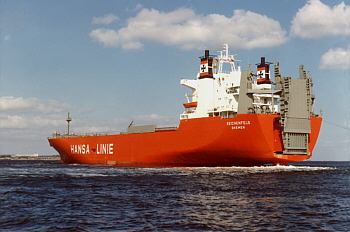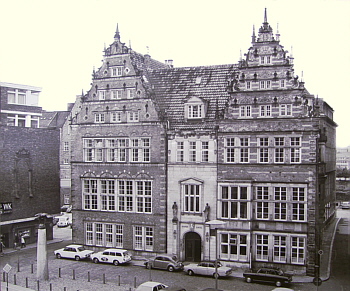December 3, 1881
A commitee of traders in Bremen and Bremerhaven
come together for a constitutional general meeting and found the
Deutsche Dampfschifffahrts-Gesellschaft "HANSA"
headquartered in Bremen. The purpose of this company DDG Hansa is the
construction of regular shipping lines.
The traders intended to put steamboats into operation, steam vessels of about 2500
- 3000 tons for a "world-wide service", steamers of about 1200 - 1500 tons
for a "Mediterranian service" and steamboats of about 600 tons for a
"Baltic Sea service".

STOLZENFELS (1)
In 1882 three large steam vessels were bought in Great Britain and one smaller
steamboat was ordered in Germany.
Until the beginning of the First World War the fleet was continuously built up by
the management of the shipping company merchant
Oltmann Johann Dietrich Ahlers
from Elsfleth. In the history of the company only one steamboat got the
name of a person, it was the O.J.D. AHLERS.
August 1, 1914
The beginning of the First World War immediately interrupted the steamer service
lines.
The fleet of the DDG Hansa consisted of 68 steam vessels and one motor ship when
the war broke out.
Additionally there was a fleet of tugs, sea barges and barges for coastal and
harbour service.
Many steam vessels were captured or interned. Only a few steam boats remained
within the German territory.
November 11, 1918
After the signing of the armistice all
steam vessels including newbuildings (even the steamer GEIERFELS (1), ready in June 1920)
had to be deposited. The company only had left the small steamboat SONECK (2), the barge
fleet and the steam tugs.
The rebuilding of the steamer fleet began with the FRAUENFELS (1), completed in 1921. The
lines could gradually be started too. In 1921 an extensive reconstruction programme was
started, altogether 12 ships including the STURMFELS (2). The first large motor ships were
given back to the company starting with the ROLANDSECK (2) from the year 1912 and the
SCHWARZENFELS (3), delivered in 1925. In 1929 heavy goods transport service began with the
delivery of the steam vessel LICHTENFELS (2). The ship had the useful piece of equipment,
a derrick of 120 tons lift capacity. Before the Second World War further eight large motor
ships of the EHRENFELS - class were delivered and in 1940 the MOLTKEFELS (2) was
added.
September 1, 1939
The Second World War again interrupted the
arduous reconstruction of the fleet. All the line-services were stopped. A large number of
vessels was sent to the bottom, were captured or interned in neutral ports. The DDG Hansa
fleet consisted of 31 steam vessels, 13 motor vessels and 37 barges and tenders for
harbour service. Up to the armistice quite a number of ships were built on German yards as
replacements for the lost ships. Shipping companies were founded to do the managing of the
ships for the German government (Deutsches Reich). The need for transport volume was
larger than in the First World War.
Mai 8, 1945
After the Second World War all the steamers and
motor vessels had been withdrawn from the DDG Hansa. Until the end of 1949 only the sea
barge and coastal ship IRAN and IRAK were in the possession of the company. The Petersberg
Resolution (Petersberger Abkommen) was loosened at the end of 1949 and so the
reconstruction of the fleet could start again. The first large steamer ARGENFELS (3) could
be engaged already in 1950. The reconstruction made great progress. In 1954 the first ship
of the "Picasso-class", the LICHTENFELS (3), was delivered by the yard. The next
even larger classes were the W - class and the WN - class. The last conventional
freighters were used in 1970 for the first time. From this class the
GOLDENFELS (5) was delivered as a semi-container ship and the GEYERFELS was
delivered as a complete container ship. A new generation of container/ roll
-on-roll-off-ships was started and put into the fleet by the use of the
RABENFELS (4) in 1977.

REICHENFELS (5)
Attempts in other fields of navigation were started with more or less success. The
KATTENTURM (4) was the first supply vessel for oil rigs or sea construction sites put into
the fleet. Until the breakdown the DDG Hansa added more than 50 supply vessels to the
service. In this area a co-operation took place between the Deutschen
Dampfschifffahrts-Gesellschaft "HANSA", Bremen and the Vereinigten Tanklager und
Transpormittel GmbH (VTG), Hamburg and the Offshore Marine Ltd., Rochester / Great
Britain. The new company was the Offshore Supply Association Ltd. (OSA), London. But after
five years the OM left the OSA again.
August 18, 1980
In 1976 the distribution of dividends was about
12%. In 1977 however dividends could not be paid any longer. The losses went up higher and
higher, starting from 1978, and on August 18, 1980 the company was compelled to apply for
the opening of insolvency proceedings at the court ( Amtsgericht Bremen). Consequently the
services and lines were stopped and the ships were sold. A winding-up arrangement was
finished on July 3, 1989 at a rate of about 60 %.
December 31, 1989
The DDG Hansa joint-stock company in a liquidation process was deleted from
the register of companies (Handelsregister Bremen).

The DDG Hansa management centre An der Schlachte 6 |